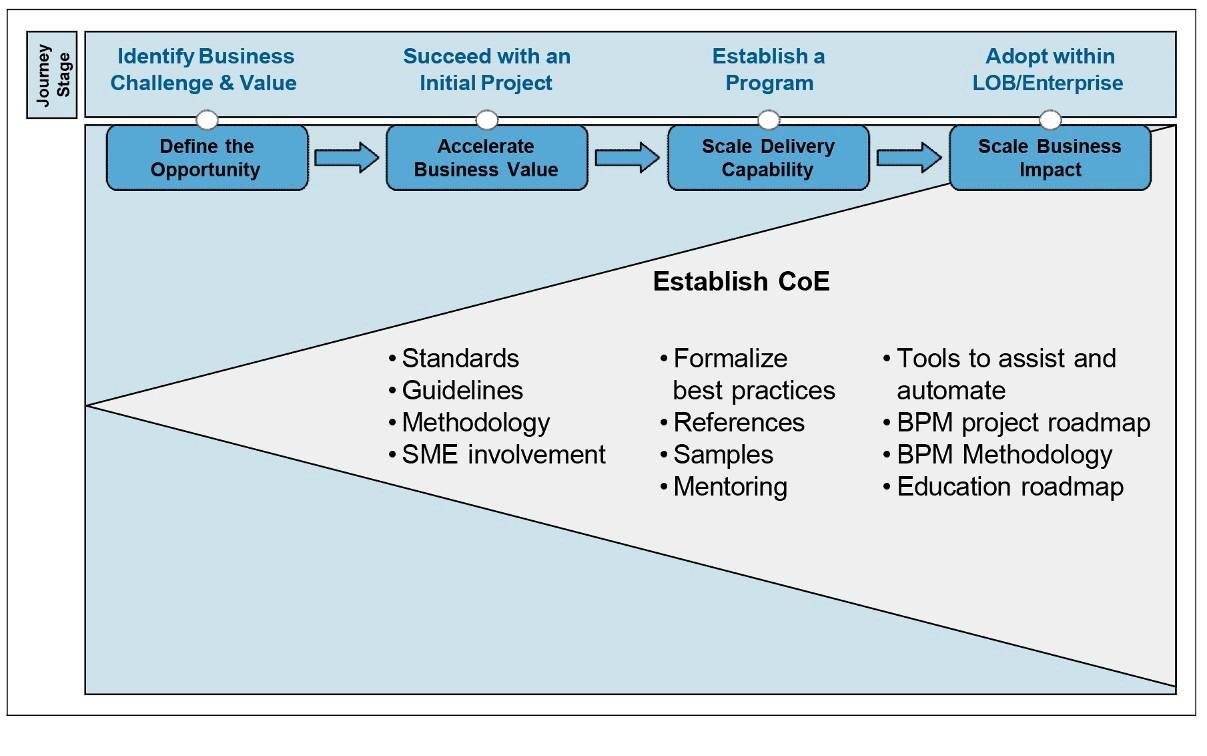Establishing the BPM Center of Excellence
The operating model explicitly includes a BPM CoE to direct the BPM design team and BPM solution teams, and to champion and evangelize BPM across the company. This section explores the BPM CoE in more detail and the challenges that it addresses and its goals and responsibilities.
Why we need a BPM CoE
When beginning your journey with BPM within an organization, you encounter challenges that your organization can address by establishing a BPM CoE. Typical challenges include:
- Projects under-delivering on the original business value case
- Alignment difficulties between business and IT
- Different methods and standards across BPM projects
- Lack of coordination within the organization, leading to suboptimal usage of resources
The previously mentioned points illustrate why strong executive sponsorship and effective working relationships between all departments in an organization are essential, and the charter of the BPM Center of Excellence is to ensure that these conditions exist.
The charter of the BPM Center of Excellence
The mission and goals of the BPM CoE are to ensure the success of the organization’s BPM approach and initiatives by providing business solutions that support the organization’s strategy and goals. The goals of the BPM CoE are:
- To provide a single entity for using standardized methods, tools, assets, skills, and resources for the organization
- To foster clear communication and coordination between business and IT along the BPM journey
- To ensure alignment with business architecture, process ownership, and the overall enterprise
- To provide and manage BPM policies and procedures
- To identify BPM roles and map them within the organization
Core responsibilities of the BPM CoE
The BPM CoE mission and goals provide a clear starting point in determining the core responsibilities:
- Managing and maintaining BPM portfolio planning, including coordination between BPM projects
- Managing the status of BPM projects
- Determining, implementing, and promoting the adoption of BPM standards and policies
- Tracking delivered BPM value through established metrics
- Managing and maintaining the deployed process models
- Supplying and maintaining skills for BPM initiatives
- Gathering and establishing best practices
- Maintaining and promoting reusable BPM assets
- Developing custom value-adding tools for the enterprise
- Fostering processing (and even business model) innovation
- Delivering BPM education
Evaluating the success of the BPM CoE
At the setup of the BPM CoE, the success criteria and the metrics to measure success should be included in the BPM CoE charter. This action ensures the focus and direction needed to maintain executive support. The BPM CoE metrics should be directly related to its responsibilities and characterize the value of the CoE.
The number of BPM projects for which the BPM CoE provides resources and consultancy are good candidates for determining return on investment (ROI) of the BPM CoE. The reuse of assets on BPM projects is in the same category. Less tangible, but valid, is the number of projects within budget, schedule, and with the expected business value delivered.
How the BPM CoE evolves
Typically, a BPM CoE is not established with the initial BPM project. It is established when the first BPM project is extended into a BPM program.

Proposed approach for establishing the BPM CoE
The proposed approach for establishing a CoE includes the following phases:
- Planning and establishing a roadmap
- Implementing the roadmap
- Activating the BPM CoE
Planning and establishing a roadmap
First, you need to socialize the BPM CoE and the business process governance and operational models. The obtained feedback is then incorporated into a formal charter for the BPM CoE. The BPM CoE charter contains:
- The mission
- The scope
- The roles and responsibilities
- The governance framework
- The mentoring and education plan
- The processes and procedures
Implementing the roadmap
The implementation starts with identifying the CoE human resources and then training them on methods and tools. The operating model needs to be further formalized, and any questions about the working of the operating model need to be clarified.
Define the standard performance metrics that serve as a baseline for all BPM projects. Then you integrate the defined performance metrics into a common reporting process. Also include a change readiness assessment in the implementation of the roadmap.
Activating the BPM CoE
Start by deploying the CoE on the first BPM project. The feedback from this first BPM project is used to evaluate the contribution by CoE resources and to refine the operating model. You build upon the change readiness assessment from the implementation step to create and execute a change management plan.
